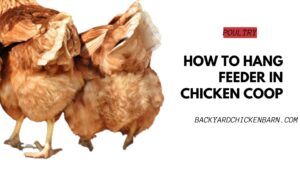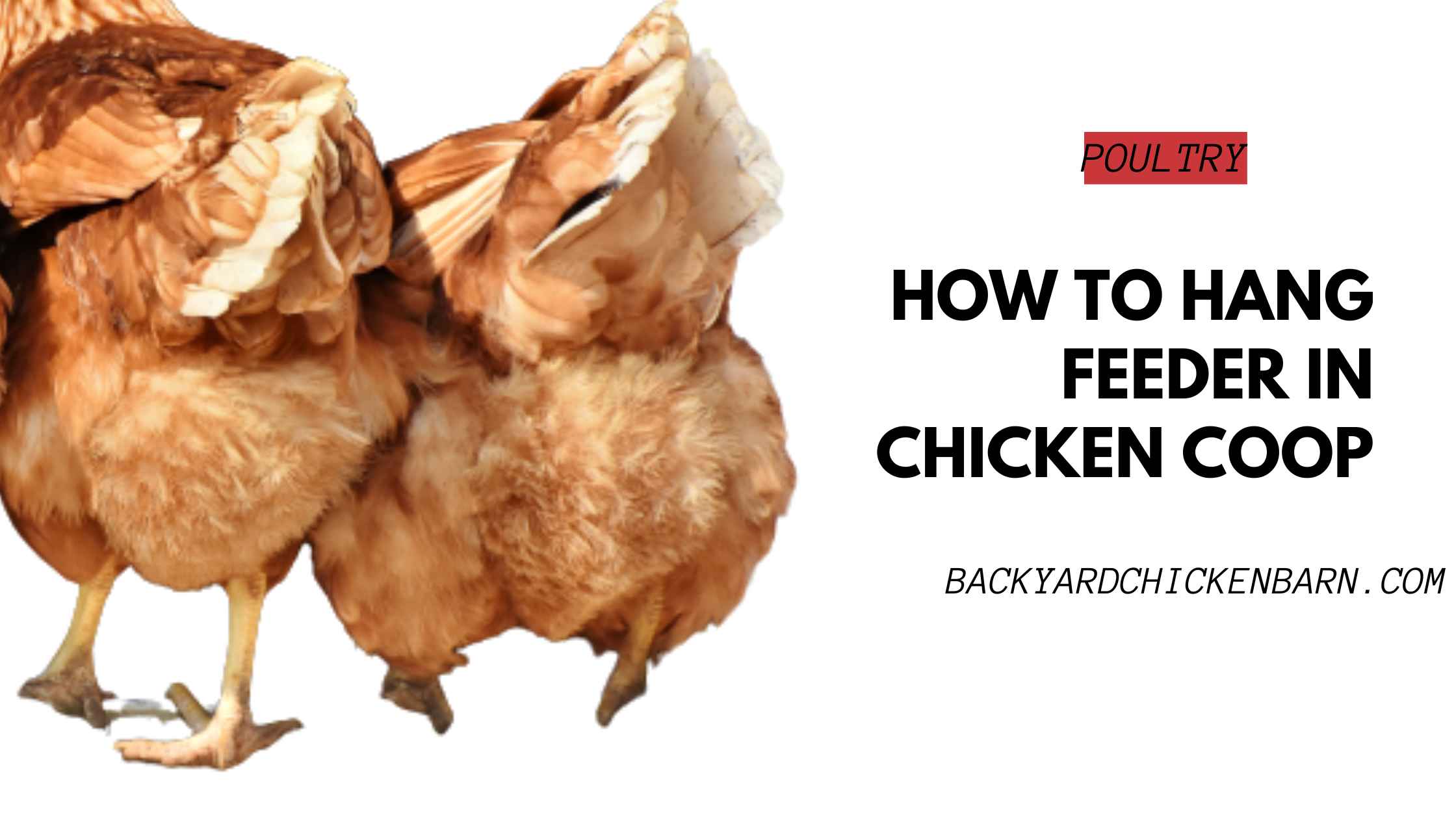How to Hang Feeder in Chicken Coop
My initiation into the world of backyard poultry was filled with excitement, anticipation, and, yes, a fair share of beginner blunders. Among the many tasks I aimed to perfect was ensuring my chickens had easy and consistent access to their feed.
So, I delved deep into the art of hanging feeders in the coop.
To answer the question upfront: hang the chicken feeder at the height of the back of the average chicken in your flock. This ensures they can comfortably access the feed while reducing the chances of contamination from dirt, waste, or active scratching.
The process, however, offered more nuances than I had originally imagined. Here’s my comprehensive guide on the how and why of hanging chicken feeders:
Why Hang Feeders?
- Cleanliness: Raising feeders off the ground keeps the feed away from dirt and droppings.
- Pest Control: Elevated feeders can deter rodents and other pests from accessing the feed.
- Economy: Less feed gets wasted as chickens are less likely to scratch at and spill elevated feed.
Selecting the Right Feeder:
When I started, I assumed any feeder would do. But I soon realized the importance of choosing a feeder with a design conducive to hanging, preferably with a central attachment point to maintain balance.
Height is Crucial:
The best practice I adopted was to hang the feeder at the back height of my average chicken.
This keeps the feed accessible to all birds, irrespective of their size, and prevents them from stepping into their feed.
Secure Attachments
A sturdy chain or rope is ideal for hanging. Over time, I’ve found that adjustable hooks or pulley systems work wonders in effortlessly altering the feeder’s height as my chickens grew.
Location Matters
I aimed to place my feeder in a dry area of the coop, away from perches (to avoid droppings) and preferably close to their water source for their convenience.
Monitoring and Maintenance
Hanging feeders reduce, but don’t eliminate, cleaning chores. I make it a point to regularly check for any mold, dampness, or feed clogs.
A quick weekly check and monthly deep clean have become my norm.
Addressing Bullying
One unforeseen advantage of hanging feeders was the reduction in feeder bullying.
With an elevated feeder, dominant birds found it harder to guard all access points, ensuring that even my timid hens got their fair share.
Go DIY or Buy?
Initially, I purchased a basic hanging feeder. But as I grew more confident, I explored DIY options, crafting feeders from PVC pipes and large containers.
This allowed me to customize the feeder’s size based on my flock’s needs.
In conclusion, while the process might seem straightforward, the nuances of hanging a chicken feeder efficiently can make a significant difference in maintaining a clean, harmonious, and efficient coop environment.
I cherish the learning curve, and today, my hanging feeder stands as a testament to the dedication I have for my feathery friends.
ALSO SEE: What Color Should I Paint My Chicken Coop?

FAQs on Hanging Chicken Feeders
1. Why should I consider hanging my chicken feeder? Hanging feeders promote cleanliness, deter pests, and minimize feed wastage.
2. What height should the feeder be off the ground? Hang it at the height of the back of the average chicken in your flock.
3. Can any chicken feeder be hung? Preferably choose feeders designed for hanging, usually ones with a central attachment point for balance.
4. How does hanging the feeder help in cleanliness? Raising feeders off the ground keeps the feed away from dirt, droppings, and reduces scratching-induced spillage.
5. Will a hanging feeder deter pests? Yes, elevated feeders can make it harder for rodents and other pests to access the feed.
6. How do I choose the right feeder for hanging? Opt for feeders with a design conducive to hanging and a central attachment point to maintain balance.
7. What should I use to hang my feeder? A sturdy chain, rope, or an adjustable hook or pulley system works best.
8. Where should I position my hanging feeder in the coop? Place it in a dry area, away from perches to avoid droppings, and preferably close to their water source.
9. How often should I check my hanging feeder? A quick weekly check and a monthly deep clean are recommended.
10. Can hanging feeders reduce bullying among chickens? Yes, with an elevated feeder, dominant birds find it harder to guard all access points.
11. Are DIY hanging feeders a good idea? Certainly! DIY feeders allow customization based on flock needs and can be crafted from materials like PVC pipes or large containers.
12. Are hanging feeders suitable for all chicken sizes? Yes, but ensure you adjust the height to suit the average chicken size in your flock.
13. Can I hang my waterer similar to the feeder? Yes, hanging waterers can also keep water clean and reduce contamination.
14. Do hanging feeders prevent feed mold and dampness? They help reduce it, but regular checks are essential to ensure the feed stays dry.
15. What are the signs of a poorly hung feeder? Feed spillage, difficulty in access by smaller chickens, or frequent tipping are indicators.
16. How large should a hanging feeder be? It depends on the size and number of chickens. Ensure that it can hold enough feed for at least a day.
17. Can hanging feeders be used outdoors? Yes, but ensure they’re placed under shelter to avoid rainwater contamination.
18. How do hanging feeders help in feed economy? Elevated feeders reduce chickens’ tendency to scratch at and spill their feed.
19. Are hanging feeders expensive? Prices vary, but there are affordable options available. DIY can also be cost-effective.
20. Are there any downsides to hanging feeders? If not hung at the right height or if not maintained, they can pose challenges. But with proper care, the benefits outweigh the downsides.
21. How do I prevent my feeder from swinging too much? Ensure it’s securely fastened and consider placing a weight or stabilizer at the bottom.
22. What materials are best for a DIY hanging feeder? PVC pipes and large containers are popular choices.
23. How do I adjust the height as my chicks grow? An adjustable hook or pulley system allows for easy height modification.
24. Should the feeder be hung in the center or side of the coop? While positioning depends on coop design, ensuring it’s away from perches and in a dry area is key.
25. Will my chickens take time to adapt to a hanging feeder? Chickens typically adapt quickly, but ensure it’s at the right height for easy access.
26. How do I know if my feeder is at the right height? If all chickens, irrespective of their size, can access the feed without stretching or crouching, it’s at a good height.
27. Is the feeder’s balance important? Yes, an unbalanced feeder can tip over, spill feed, or become inaccessible.
28. Can I use multiple small hanging feeders instead of one large one? Certainly! Multiple feeders can even help reduce bullying and feed competition.
29. What type of feed works best with hanging feeders? Pellets or crumbles are ideal, as they’re less likely to spill than mash or powders.
30. How do I ensure the feeder doesn’t get clogged? Regular checks and choosing feeders with good flow design can prevent clogs.
31. Can I hang supplemental feed or treats the same way? Yes, just ensure the chickens can access them without difficulty.
32. Does the type of hanging material (chain vs. rope) make a difference? Both can work well; the key is to ensure the material is sturdy and durable.
33. Can I add a tray beneath my hanging feeder? Yes, a tray can further reduce spillage and keep the area clean.
34. How does feeder design affect spillage? Feeders with deeper trays or lip designs can minimize spillage.
35. Is a hanging feeder suitable for a mixed flock with birds of different sizes? Yes, but adjust the height to accommodate the average bird size.
36. How can I prevent water from getting into my hanging feeder? Position it under a shelter or use a feeder with a cover or hood.
37. What’s the advantage of a pulley system for hanging? A pulley system allows easy height adjustments without manually lifting the feeder.
38. Do hanging feeders attract fewer pests than ground feeders? Generally, yes. Elevating feeders can deter many ground-based pests.
39. How do I know when to refill the feeder? Regular checks will help, but some feeders come with transparent sections or indicators to show feed levels.
40. Can I automate the refilling of a hanging feeder? Yes, some advanced feeders can be integrated with automatic refilling systems or hoppers.


